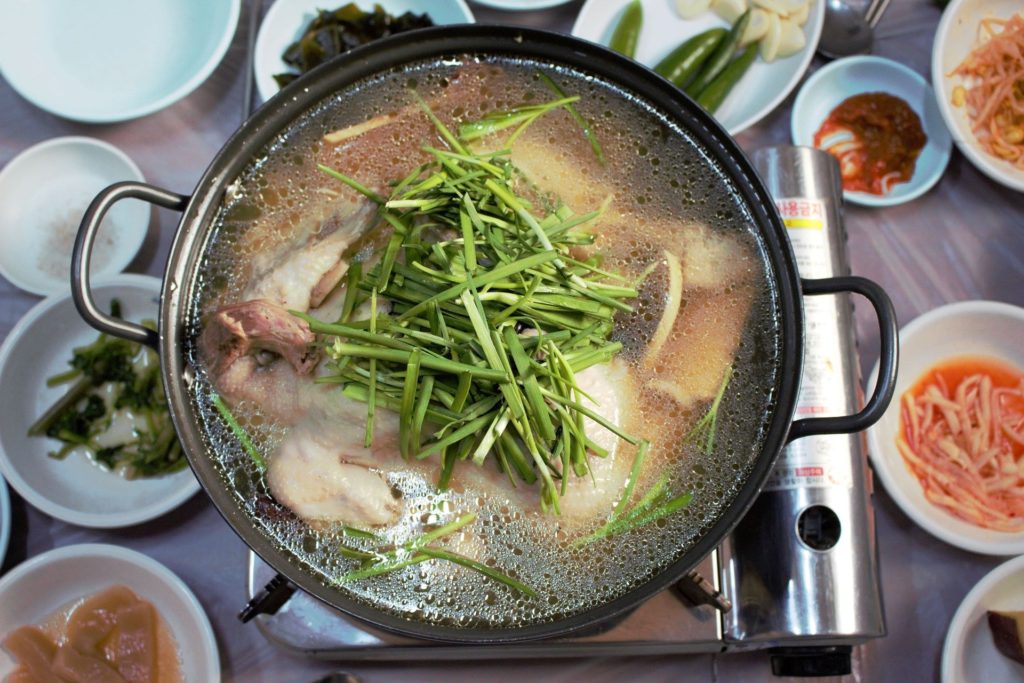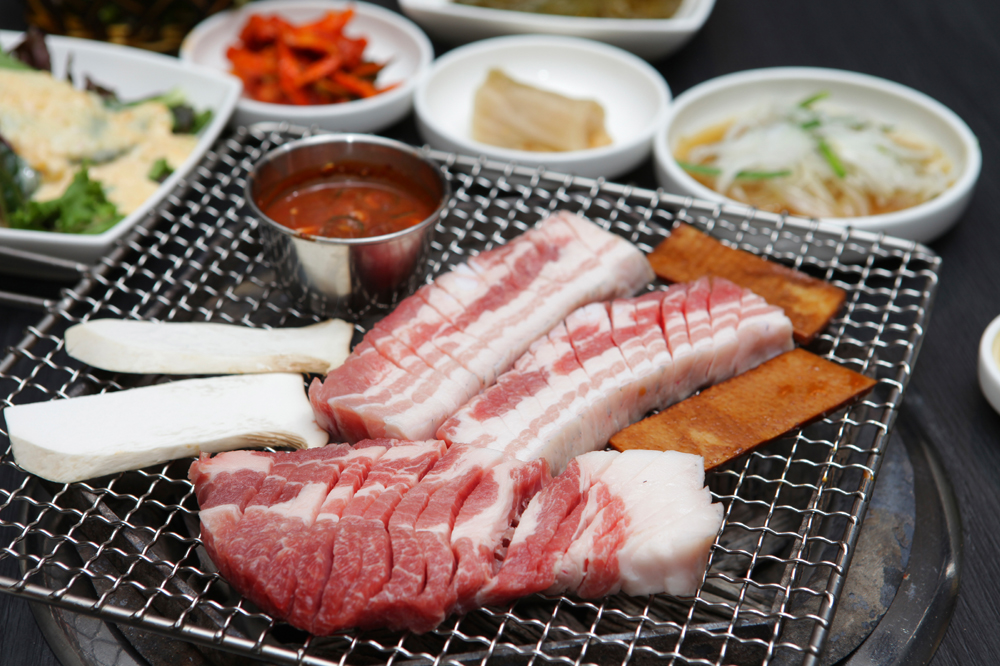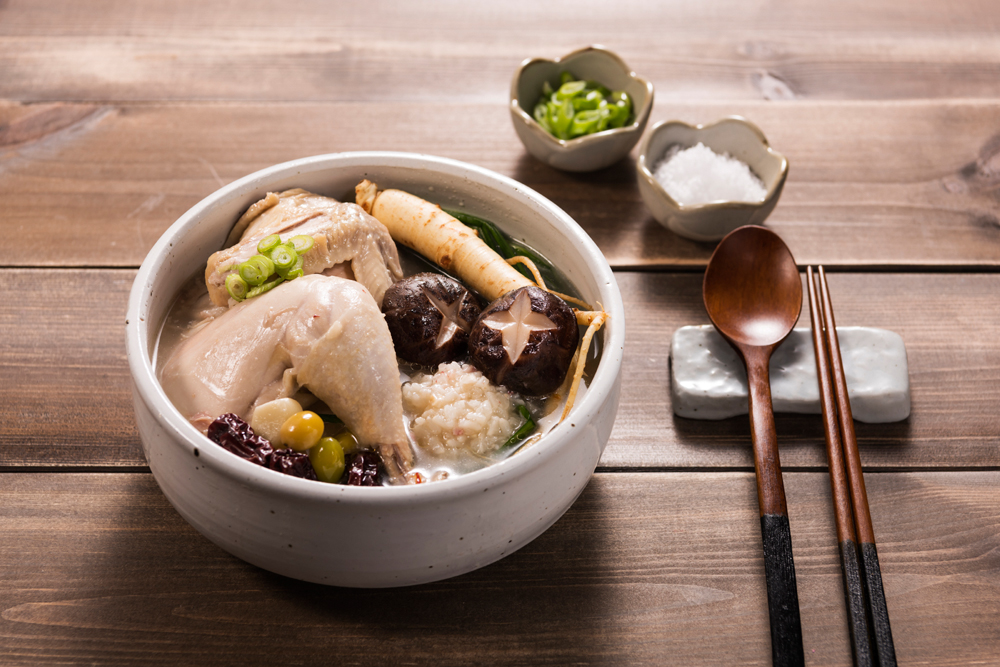Samgye-tang for the Heat, Pork for Pollution
The heat of summer is quickly approaching, and the air quality index for Gwangju is outside the “good” zone for most of the year; indeed, it was high in the “moderate” zone at the time of this writing. The weather is beginning to heat up. The seasonal term, Ipha (입하, Entrance of Summer) fell on May 5 this year and the summer solstice (Haji, 하지) is on June 21. And following soon after that are the three Boknal (복날, Dog Days) of summer. To endure these climatic conditions, Koreans have turned to foods: samgye-tang, a chicken stew to beat the heat, and pork to protect against the ill effects of polluted air. Here we bring you articles on the medicinal qualities of these Korean foods: “Beat the Heat with Samgye-tang,” written by Stephen Redeker (Gwangju News, April 2012) and “Does Eating Pork Protect You from Pollution?” penned by C. Adam Volle (Gwangju News, April 2014). — Ed.
Beat the Heat with Samgye-tang
Samgye-tang (삼계탕) is a popular dish in Korea consisting of a whole boiled chicken filled with rice, ginseng root, jujube, and garlic, and served in broth. It is eaten all year round, but Koreans especially enjoy eating it on the three “special” days occurring in July and August, the three “dog days” (Boknal, 복날), called Chobok (초복), Jungbok (중복), and Malbok (말복). These days symbolize the three hottest days of summer. Traditionally, samgye-tang is eaten for the purpose of restoring stamina and health to a person exhausted from the summer heat. On the days mentioned above, crowds now line up outside restaurants just to have a bowl of samgye-tang.
Is samgye-tang really the best thing to eat on a hot summer day? Is the Korean belief that it recharges the body and mind really true, or is it just a tradition that continues today without real proof that it works? In Western culture, some people believe eating chicken soup will help cure a person of the common cold. Science leans more towards vitamin C as the common cold killer, but people still make a habit of eating delicious chicken soup when they get sick. In Korea, people also believe that a whole chicken, usually a pullet, combined with other healthy ingredients, can prevent sickness and revitalize the body. However, there are a number of different items that can be eaten to better relieve the body on a hot day than Korean chicken stew.

In the old days, escaping the summer heat was a difficult task, so naturally people turned to food for relief. Originally, boshin-tang (보신탕, soup containing dogmeat) was served to eager Koreans looking for health benefits during the dog days of summer. This meat is full of protein, low in cholesterol, and generally softer than beef, pork, or chicken, which makes it easier for the body to digest. However, these days dogmeat has lost its popularity as a dog-day delicacy and has been replaced with boiled chicken soup.
We should ingest a variety of proteins, carbohydrates, and vitamins when our bodies are drained. Obviously a must-have on a hot summer day is a glass of water because the body perspires much more and becomes dehydrated. When it comes to protein, whole grains are a good source and also contain iron and vitamin B. Brown rice and wholegrain bread are ways to get that into your system. The same content can be obtained from meats like beef or pork liver, turkey (unfortunately rare in Korea), and seafoods such as clams, shrimp, and fish. Steering clear of meats with high fat content will strengthen the health benefits of the proteins and essential vitamins.
Vegetables also play a major role in supplying the body with much-needed nutrients. Cooked soybeans contain a large amount of protein, iron, and vitamin B. This also extends to other soy products like soy milk and tofu. Kale, broccoli, and collard greens are all good sources of energy-boosting nutrients, but none can top spinach. Cooked spinach boasts the highest iron content among plant-based foods. It also delivers vitamins A, C, and E, potassium, magnesium, calcium, and dietary fiber.
So, even though samgye-tang is not the most potent way to revive a tired, energy-depleted body on the hottest days of summer, there is little doubt that it is a healthy food to eat all year round. Reserving special days to eat something so delicious should continue, regardless. If we really wanted to make a meal super-powered enough to charge our bodies with what it needs, it would probably look like this: Take the traditional samgye-tang recipe but switch the white rice to brown rice, stuff the skinless chicken full of spinach, broccoli, and tofu, with sides of fish, beef, and pork, and serve it with two glasses of soy milk. Now that is a hearty meal worth sweating for!
Pork for Pollution Protection
With lead-laced fog continuing to roll into South Korea from China, some people are hoping that eating pork does have the effect of protecting one from pollution. According to a story published in The Korea Times, E-Mart alone sold 48.3 percent more pork from February 14 to 27, which is within the seasonal peak air pollution period.
The idea of eating pork to purify the body is a uniquely Korean home remedy, an idea born of tradition rather than science. The Korea Times’ story suggests that the belief became popular when Korean miners – frequent inhalers of unhealthy dust – supposedly started eating pork after they emerged from their tunnels.

Proponents of the cure have attempted to explain scientifically why they think pork works. One livestock supplier suggested to the Seoul Economic Daily that unsaturated heavy acids, of which pork has many, help to expel the heavy metal particles that make Chinese air so concerning. In a December 2013 story, the South China Morning Post wrote that many Koreans believe samgyeop-sal (삼겹살, grilled pork belly) is a “health food rich in vitamin B that can lower cholesterol, detoxify the lungs, and cleanse the skin.”
Respectable nutritionists unanimously agree, though, that the opposite is true: Eating pork introduces more toxins into the system, can block already-present toxins from escaping, and is certainly not good for people’s skin. Not eating pork at all might be much healthier than eating the amount of pork consumed by the average Korean.
The main reason has to do with the source of pork, the pig. Unlike many other animals (and people), pigs do not spend much time digesting their food, so there is little chance for the pigs’ bodies to remove the toxins they have ingested. Moreover, there is no place for the toxins to go; pigs do not sweat, so everything they absorb goes into their tissues – which we eat.
And while a grill full of samgyeop-sal will not create new acne, it may worsen any pre-existing skin conditions. Like all meat, pork will raise the body’s insulin levels and its acidity, both of which can cause inflammation, which aggravates acne.
Rather than eating pork, one would be better off eating a pear, another Korean home remedy against pollution. The pear will not protect against the Chinese dust either, but it will be healthier for you, and it will not worsen your skin.
Arranged by David Shaffer.



